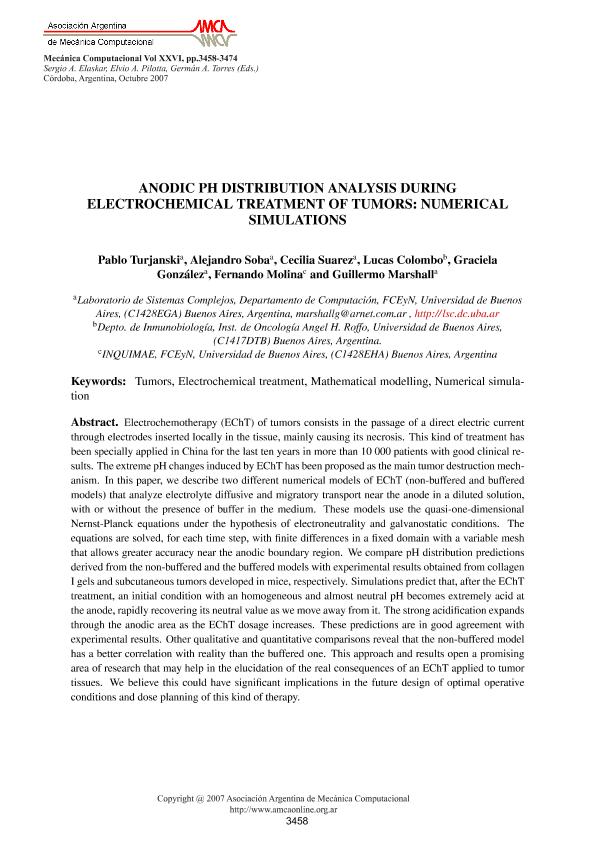Mostrar el registro sencillo del ítem
dc.contributor.author
Turjanski, Pablo Guillermo

dc.contributor.author
Soba, Alejandro

dc.contributor.author
Suarez, Cecilia
dc.contributor.author
Colombo, Lucas Luis

dc.contributor.author
González, Graciela
dc.contributor.author
Molina, Fernando Víctor

dc.contributor.author
Marshall, Guillermo Ricardo

dc.date.available
2022-08-02T17:04:50Z
dc.date.issued
2007-12
dc.identifier.citation
Turjanski, Pablo Guillermo; Soba, Alejandro; Suarez, Cecilia; Colombo, Lucas Luis; González, Graciela; et al.; Anodic ph distribution analysis during electrochemical treatment of tumors: numerical simulations; Asociación Argentina de Mecánica Computacional; Mecánica Computacional; XXVI; 40; 12-2007; 3458-3474
dc.identifier.issn
2591-3522
dc.identifier.uri
http://hdl.handle.net/11336/163921
dc.description.abstract
Electrochemotherapy (EChT) of tumors consists in the passage of a direct electric current through electrodes inserted locally in the tissue, mainly causing its necrosis. This kind of treatment has been specially applied in China for the last ten years in more than 10 000 patients with good clinical results. The extreme pH changes induced by EChT has been proposed as the main tumor destruction mechanism. In this paper, we describe two different numerical models of EChT (non-buffered and buffered models) that analyze electrolyte diffusive and migratory transport near the anode in a diluted solution, with or without the presence of buffer in the medium. These models use the quasi-one-dimensional Nernst-Planck equations under the hypothesis of electroneutrality and galvanostatic conditions. The equations are solved, for each time step, with finite differences in a fixed domain with a variable mesh that allows greater accuracy near the anodic boundary region. We compare pH distribution predictions derived from the non-buffered and the buffered models with experimental results obtained from collagen I gels and subcutaneous tumors developed in mice, respectively. Simulations predict that, after the EChT treatment, an initial condition with an homogeneous and almost neutral pH becomes extremely acid at the anode, rapidly recovering its neutral value as we move away from it. The strong acidification expands through the anodic area as the EChT dosage increases. These predictions are in good agreement with experimental results. Other qualitative and quantitative comparisons reveal that the non-buffered model has a better correlation with reality than the buffered one. This approach and results open a promising area of research that may help in the elucidation of the real consequences of an EChT applied to tumor tissues. We believe this could have significant implications in the future design of optimal operative conditions and dose planning of this kind of therapy.
dc.format
application/pdf
dc.language.iso
eng
dc.publisher
Asociación Argentina de Mecánica Computacional
dc.rights
info:eu-repo/semantics/openAccess
dc.rights.uri
https://creativecommons.org/licenses/by-nc-sa/2.5/ar/
dc.subject
Tumors
dc.subject
Electrochemical treatment
dc.subject
Mathematical modelling
dc.subject
Numerical simulation
dc.subject.classification
Oncología

dc.subject.classification
Medicina Clínica

dc.subject.classification
CIENCIAS MÉDICAS Y DE LA SALUD

dc.title
Anodic ph distribution analysis during electrochemical treatment of tumors: numerical simulations
dc.type
info:eu-repo/semantics/article
dc.type
info:ar-repo/semantics/artículo
dc.type
info:eu-repo/semantics/publishedVersion
dc.date.updated
2022-07-15T15:25:02Z
dc.journal.volume
XXVI
dc.journal.number
40
dc.journal.pagination
3458-3474
dc.journal.pais
Argentina

dc.journal.ciudad
Córdoba
dc.description.fil
Fil: Turjanski, Pablo Guillermo. Consejo Nacional de Investigaciones Científicas y Técnicas; Argentina. Universidad de Buenos Aires. Facultad de Ingeniería. Departamento de Computación. Laboratorio de Sistemas Complejos; Argentina
dc.description.fil
Fil: Soba, Alejandro. Consejo Nacional de Investigaciones Científicas y Técnicas; Argentina. Universidad de Buenos Aires. Facultad de Ingeniería. Departamento de Computación. Laboratorio de Sistemas Complejos; Argentina
dc.description.fil
Fil: Suarez, Cecilia. Universidad de Buenos Aires. Facultad de Ingeniería. Departamento de Computación. Laboratorio de Sistemas Complejos; Argentina
dc.description.fil
Fil: Colombo, Lucas Luis. Consejo Nacional de Investigaciones Científicas y Técnicas; Argentina. Universidad de Buenos Aires. Facultad de Medicina. Instituto de Oncología "Ángel H. Roffo"; Argentina
dc.description.fil
Fil: González, Graciela. Universidad de Buenos Aires. Facultad de Ingeniería. Departamento de Computación. Laboratorio de Sistemas Complejos; Argentina
dc.description.fil
Fil: Molina, Fernando Víctor. Consejo Nacional de Investigaciones Científicas y Técnicas. Oficina de Coordinación Administrativa Ciudad Universitaria. Instituto de Química, Física de los Materiales, Medioambiente y Energía. Universidad de Buenos Aires. Facultad de Ciencias Exactas y Naturales. Instituto de Química, Física de los Materiales, Medioambiente y Energía; Argentina
dc.description.fil
Fil: Marshall, Guillermo Ricardo. Universidad de Buenos Aires. Facultad de Ingeniería. Departamento de Computación. Laboratorio de Sistemas Complejos; Argentina. Consejo Nacional de Investigaciones Científicas y Técnicas; Argentina
dc.journal.title
Mecánica Computacional
dc.relation.alternativeid
info:eu-repo/semantics/altIdentifier/url/http://venus.santafe-conicet.gov.ar/ojs/index.php/mc/article/view/1355
Archivos asociados
